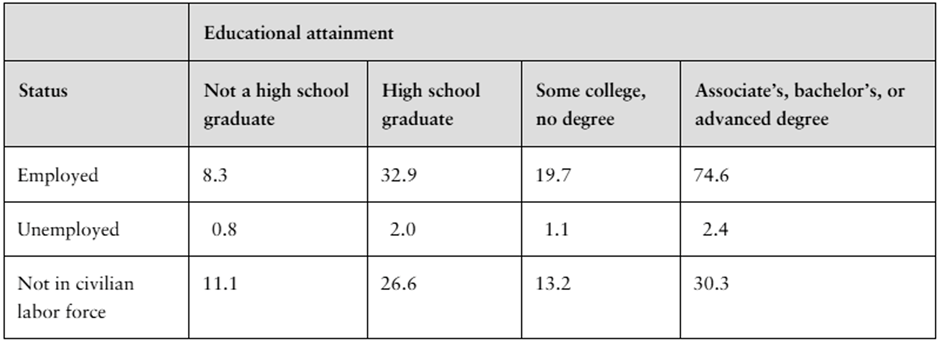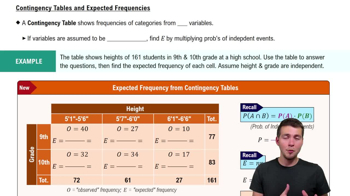The table below shows the results from a drug trial for a new ADHD medication. Find the frequencies that we would expect if improvement of symptoms was independent of whether a participant received the placebo.
Table of contents
- 1. Intro to Stats and Collecting Data55m
- 2. Describing Data with Tables and Graphs1h 55m
- 3. Describing Data Numerically1h 45m
- 4. Probability2h 16m
- 5. Binomial Distribution & Discrete Random Variables2h 33m
- 6. Normal Distribution and Continuous Random Variables1h 38m
- 7. Sampling Distributions & Confidence Intervals: Mean1h 53m
- 8. Sampling Distributions & Confidence Intervals: Proportion1h 12m
- 9. Hypothesis Testing for One Sample2h 19m
- 10. Hypothesis Testing for Two Samples3h 22m
- 11. Correlation1h 6m
- 12. Regression1h 4m
- 13. Chi-Square Tests & Goodness of Fit1h 20m
- 14. ANOVA1h 0m
13. Chi-Square Tests & Goodness of Fit
Contingency Tables
Problem 10.2.36
Textbook Question
Contingency Tables and Relative Frequencies In Exercises 33–36, use the information below.
The frequencies in a contingency table can be written as relative frequencies by dividing each frequency by the sample size. The contingency table below shows the number of U.S. adults (in millions) ages 25 and over by employment status and educational attainment. (Adapted from U.S. Census Bureau)

What percent of U.S. adults ages 25 and over (a) are employed and are only high school graduates, (b) are not in the civilian labor force, and (c) are not high school graduates?
 Verified step by step guidance
Verified step by step guidance1
Step 1: Calculate the total sample size by summing all the frequencies in the contingency table. Add all the values across rows and columns to find the total number of U.S. adults ages 25 and over.
Step 2: To find the percentage of U.S. adults who are employed and are only high school graduates, divide the frequency for 'Employed' and 'High school graduate' (32.9) by the total sample size calculated in Step 1. Multiply the result by 100 to convert it to a percentage.
Step 3: To find the percentage of U.S. adults who are not in the civilian labor force, divide the total frequency for 'Not in civilian labor force' (sum of 11.1, 26.6, 13.2, and 30.3) by the total sample size calculated in Step 1. Multiply the result by 100 to convert it to a percentage.
Step 4: To find the percentage of U.S. adults who are not high school graduates, divide the total frequency for 'Not a high school graduate' (sum of 8.3, 0.8, and 11.1) by the total sample size calculated in Step 1. Multiply the result by 100 to convert it to a percentage.
Step 5: Interpret the percentages calculated in Steps 2, 3, and 4 to answer parts (a), (b), and (c) of the question. Ensure the percentages are rounded appropriately if needed.
 Verified video answer for a similar problem:
Verified video answer for a similar problem:This video solution was recommended by our tutors as helpful for the problem above
Video duration:
7mPlay a video:
Was this helpful?
Key Concepts
Here are the essential concepts you must grasp in order to answer the question correctly.
Contingency Tables
A contingency table is a type of data representation that displays the frequency distribution of variables. It allows for the examination of the relationship between two categorical variables, such as employment status and educational attainment in this case. Each cell in the table represents the count of observations that fall into the corresponding categories, facilitating analysis of patterns and associations.
Recommended video:
Guided course

Contingency Tables & Expected Frequencies
Relative Frequencies
Relative frequencies are calculated by dividing the frequency of a specific category by the total number of observations in the dataset. This provides a proportion or percentage that indicates how common a particular category is relative to the whole. In the context of the question, converting frequencies to relative frequencies helps in understanding the distribution of employment status among different educational attainment levels.
Recommended video:
Guided course

Intro to Frequency Distributions
Percentages in Statistics
Percentages are a way to express a number as a fraction of 100, making it easier to compare different groups or categories. In statistics, calculating percentages from relative frequencies allows for a clearer interpretation of data, such as determining what percent of U.S. adults are employed based on their educational background. This is particularly useful in analyzing demographic data and making informed conclusions.
Recommended video:
Guided course

Parameters vs. Statistics

 8:18m
8:18mWatch next
Master Contingency Tables & Expected Frequencies with a bite sized video explanation from Patrick
Start learningRelated Videos
Related Practice
Multiple Choice
